Those of you that have followed the blog for a while know that poor tree planting is one of my pet peeves. It drives me crazy to watch tree installers use backhoes to gouge out gigantic holes and then drop in the intact root ball, clay, burlap, twine and all. But this dig-and-dump method (or “cost effective practice” according to installers) of installing trees often dooms them (the trees, not the installers) to a slow and ugly death. So in honor of Halloween, let me share my latest horror story.
Twice a day I drive down this street in NE Seattle. I’ve long admired the row of dead street trees left to remind us all of our own mortality. A few of these Liriodendron have somehow survived though “survival” seems a generous term. They’re more like zombies, slowly losing body parts but somehow still functioning until someone puts them out of their misery.
One lone tree seemed to defy all odds. Until our latest windstorm, which revealed the cause of all this arboricultural agony.
That’s right, there’s the clay-covered rootball, still intact. Only one root has managed to escape into the native soil. There may be others on the opposite side, but by now (several years after installation) there should have been sufficient root establishment to prevent failure.
Several of us have written about bare-rooting trees before, and while there’s still not consensus on the practice I think we would all agree that the tree planting in this case was not acceptable. There are better ways, and yes they take more time (or “not cost effective” according to installers), but planting trees right mean fewer replacements later.
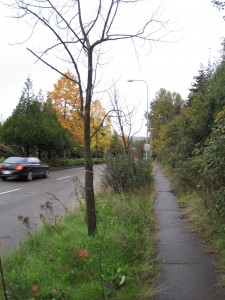
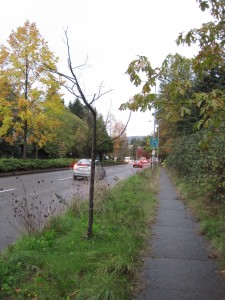
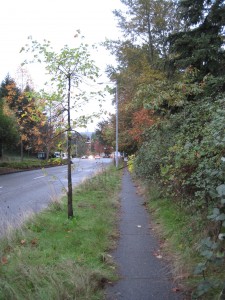
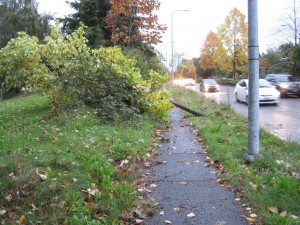

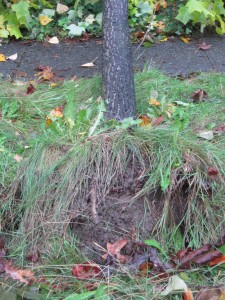
The scary part of this planting is why a tree that grows nearly to a hundred feet tall is located within inches of the roadside curb. (Also, older Liriodendron are prone to storm damage, with limbs of substantial size crashing to the pavement.) The planting method (leaving the rootball intact), I don’t sweat.
Contrary to the very unscientific assertion that tree planting that does not wash soil from the rootball “often dooms them to a slow and ugly death”, we find that deciduous trees rarely fail to thrive. When a tree dies, most often I see that this as a result of overly damp soil (poor placement) for trees that will not tolerate wetness, or that the tree was buried too deeply (poor workmanship, which is a consequence of involving humans in the process).
The percentage of deciduous trees that die (for any reason) is negligible, except for trees such as Liriodendron that we know to dig poorly. Most certainly, in the absence of more evidence there is no reason for landscapers to abandon successful planting methods for methods that require additional and careful labor, and demand extra attention following planting that is unlikely to occur with regularity.
Do the roots of tree grow into the soil that is under the road, if planted bare-root?
I just came from a community-wide tree-planting. I was asked to be a “tree captain” because I went through the Tree Steward training conducted by the Indiana Department of Natural Resources. The trees were balled in burlap with wire cages and myriad staples along with twine. Getting the trunk flare at or above ground level was emphasized as was keeping the burlap on along with the cage. On the first tree we took the burlap from around the trunk and pulled away soil to expose the flare. How could we know if the flare was at grade if we couldn’t see it? This ultimately cause a “failure” of the root ball, meaning it fell apart in the burlap so we took that off. I suggested bare-rooting, but the park staff guy said that he wanted to keep the root ball together as much as possible. He then said in the nicest way possible that his was the way not to plant a tree. We got the tree in the ground, but I believe the other 36 trees that were planted in that park (and the hundreds that were planted in other parks today) were planted with burlap and cages intact. I came home wondering why I volunteered.